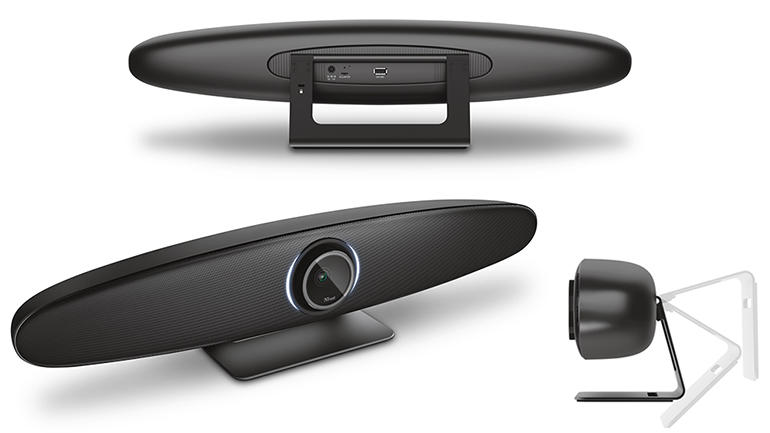As the COVID-19 pandemic (hopefully) recedes in the face of widespread vaccination, many businesses will start to reopen their offices. However, more employees will work remotely post-pandemic than did so before the coronavirus struck, because many organisations will have learned to accommodate remote working, and will have realised that the bottom line — not to mention the environment — is not necessarily best served by everyone commuting to expensive office space every day.
This means that communication and collaboration between office-based employees and the remote diaspora will become more important than ever, which is where meeting room video conferencing systems come in.
Several vendors offer video bars – devices with integrated camera, mics and speaker(s) — aimed at meeting rooms or huddle spaces hosting around 6-8 people, including Logitech (MeetUp, €1,099), Poly (Studio, €1,041) and Jabra (Panacast, €806). Now, Trust, a leading vendor of affordable electronics, is getting in on the act with a characteristically competitively priced device – the €799 / £719 IRIS. (Note: The Trust IRIS is not available for sale in the US.)

Trust IRIS: A 4K USB pan-tilt-zoom camera with an integrated speaker and microphone array, on a desktop stand (wall mount and TV mount also available).
Images: Trust
Design
The grey-black IRIS has a conventional look about it, comprising a central pan-tilt-zoom (PTZ) camera set in a flattened-oval enclosure that houses a microphone array (right side) and a mono speaker (left side). It’s mounted by default on an adjustable desk stand, but there’s a wall-mount kit in the box and a TV mounting kit is available as an optional extra. Also in the box is a 24W power adapter with a round-pin connector, EU and UK power cables, a USB cable, and a compact remote control (55g, powered by two AAA batteries).
The IRIS connects to your PC or laptop via USB (3.2) – a 3m USB-C to USB-A cable is supplied, with the USB-C (IRIS) end having a secure screw-in attachment. There’s also USB 2.0 port for attaching an optional external microphone, which is recommended if any meeting participants are likely to be over 5 metres from the integrated 4-mic array.
The camera lens has an LED status indicator ring that glows white when the IRIS is in use, blue in Bluetooth mode (when you’re pairing a phone with the IRIS for audio calls), red when the mic is muted and orange when the firmware is updating.
Various accessories are available to augment the basic IRIS kit: an external USB microphone (€129.99); a 10m USB cable (€99.99); a 15m optical USB cable (€249.99); and a VESA mount (€69.99).
Features
Like its competition, the IRIS camera supports a maximum 4K resolution (3840 x 2160 pixels), but unlike the Logitech MeetUp, Poly Studio and Jabra Panacast, it can do so at up to 60 frames per second (fps) as well as 30fps. The camera has a wide-angle lens with a 120-degree field of view, which is par for the video bar course. Also pretty standard is the camera’s 5x digital zoom capability.

Remote control: (top) disable video, switch Dynamic Range, pick up call, hang up call; (middle) camera pan/tilt, reset camera position; (bottom) volume up/down, disable mic, disable speaker, zoom in/out, manual mode, speaker mode, participant mode, presets 1 & 2, mirror video, Bluetooth mode.
Image: Charles McLellan / ZDNet
The IRIS’s imaging features are marketed as ClearView technology, and include ‘Participant mode’, where the camera automatically frames everyone in the meeting room, and ‘Speaker mode’, where a single speaker – a presenter, for example – is the focus. These modes, along with full manual PTZ control, are selectable on the bundled remote control, which also has a Dynamic Range (HDR mode) button which you can engage to ensure there’s no overexposure when participants are located in front of a window, for example.
ClearSound technology optimises the IRIS’s 4-mic array for voice audio, tracking meeting participants to ensure clear audibility, and cancelling out extraneous ambient noise. If participants are likely to be more than 5m from the integrated mic array, you may need to consider adding an external mic via the USB 2.0 port on the back of the IRIS unit.
The integrated mics are housed in the right-hand wing of the IRIS chassis, while the mono speaker is on the left wing, on an anti-vibration mounting. Speaker volume is rated at 96dB (at 0.5m), which is in line with the competition.
As well as the speaker mode and PTZ controls noted earlier, the remote has buttons for disabling video, mics and speaker, accepting and hanging up calls, resetting the camera position, and volume up/down. There are also two configurable preset buttons (press and hold for 5s to save a camera position), a ‘Mirror video’ button that flips the image horizontally, and a Bluetooth button for pairing with a smartphone for audio calls.
There’s no control software or network connection (wired or wi-fi) for remote management by the IT department. According to Trust, the IRIS is compatible with Teams, Zoom, Google Meet, GoToMeeting, Webex or ‘any other online video chat application’, but there are no formal certifications, as with some competing products.
Performance & usability

HDR mode on (top) and off (above). Note the improved image quality in the window area in HDR mode.
Images: Charles McLellan / ZDNet
Trust emphasises the IRIS’s plug-and-play credentials, with good reason: no drivers are required, and setup is simply a matter of powering up the IRIS, making a USB connection to your PC or Mac, launching your chosen video conferencing platform, and selecting the IRIS as the camera, microphone and speaker. We tested with Zoom and Skype, and had no issues.
Image quality is good, especially at 4K resolution, but although 60fps is a nice-to-have feature, most relatively static meetings will probably do just fine at 30fps. More important is Dynamic Range (HDR), which does a good job of avoiding overexposure in highly contrasted lighting conditions. Pan, tilt and zoom work smoothly via the remote control; optical zoom would give a better close-up image than (5x) digital, but that, of course, would boost the price.
The IRIS speaker’s output handles plenty of volume without distorting. All other things being equal, remote meeting participants should have no trouble being heard.
Conclusions
Trust’s IRIS video bar has a competitive price, good 4K image quality with an HDR mode for challenging lighting conditions, and a compact remote with access to plenty of functions, including tracking modes and full manual pan-tilt-zoom control. At £719, it’s a good addition to the affordable end of the video bar market.
The Trust IRIS is currently available for preorder from Amazon UK, with a release date of 22 March.
RECENT AND RELATED CONTENT
Logitech MeetUp review: A high-quality small-room conference camera
Microsoft Teams and Zoom have a new challenger (This one’s, oh, take a look)
Poly launches video conferencing portfolio that aims for broadcast quality at home
3 things you shouldn’t do before a Zoom meeting (and another 3 you should always do)
Best video conferencing software in 2021
Read more reviews



